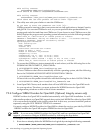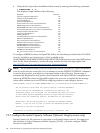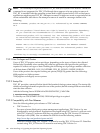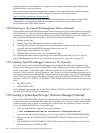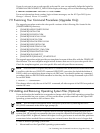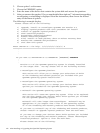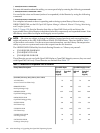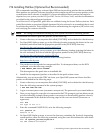
member, then all cluster members in a single-version, single-architecture OpenVMS Cluster
should be able to run the software.
For mixed-version and mixed-architecture clusters, you should obtain and install a complete
Performance Data Collector kit (TDC Version 2.2) from the following website:
http://www.hp.com/products/openvms/tdc
The complete kit provides an SDK and run-time environments for all supported OpenVMS
configurations. It supports installation on a clusterwide basis in mixed-version and
mixed-architecture OpenVMS Clusters.
7.9.10 Preparing to Use OpenVMS Management Station (Optional)
If you installed the OpenVMS Management Station software on your system (either by accepting
all default values or by selecting the component manually during the installation or upgrade
procedure), you must perform several tasks on your OpenVMS system and your PC before you
can use OpenVMS Management Station. These tasks include the following:
• Editing system files
• Starting OpenVMS Management Station on other nodes
• Verifying that you have the proper memory, disk space, media, and the required software
to install and run OpenVMS Management Station on your PC
• Installing the client software on your PC
• Defining DECnet nodes (after a new installation only)
For complete information about preparing your OpenVMS system and your PC to run the
OpenVMS Management Station server and client software, see Appendix H (page 311).
7.9.11 Installing OpenVMS Debugger Clients on a PC (Optional)
The latest version of the OpenVMS Debugger runs on OpenVMS Alpha and Integrity server
systems. The debug server runs on OpenVMS, while a debug client, which is the user interface
to the server, runs on OpenVMS and on Microsoft Windows 95, Windows 98, Windows NT,
Windows 2000, Windows XP, and Windows Vista. There is no special installation procedure for
the components that run on OpenVMS. The installation guide and kit for the OpenVMS debugger
client is located on the Layered Products CD that comes with the OpenVMS binary CD set. The
directory on the CD is DEBUG_CLIENTS011. The KIT.DIR subdirectory contains the following
files:
• 40COMUPD.EXE
• DEBUGX86011.EXE
For installation instructions, see the INSTALLATION_INFO.PS or INSTALLATION_INFO.TXT
file in the DOCUMENTATION subdirectory.
7.10 Creating a System-Specific Login Welcome Message (Optional)
You can use SYS$WELCOME to display a system-specific welcome message at login. The message
could inform users of scheduled down time, recent updates to the system, whom to contact about
system problems, and so forth. A template file is provided by the operating system. To create
your own SYS$WELCOME file, do the following:
1. Copy the template file using the following command:
$ COPY SYS$MANAGER:WELCOME.TXT SYS$SPECIFIC:[SYSMGR]WELCOME.TXT
For a clusterwide welcome message, you can copy the file to SYS$COMMON:[SYSMGR].
2. Replace the text in SYS$SPECIFIC:[SYSMGR]WELCOME.TXT with text specific to your
system.
3. Edit SYS$MANAGER:SYSTARTUP_VMS.COM to remove the exclamation point (!) from
the line that defines SYS$WELCOME.
150 After Installing or Upgrading the OpenVMS Operating System





